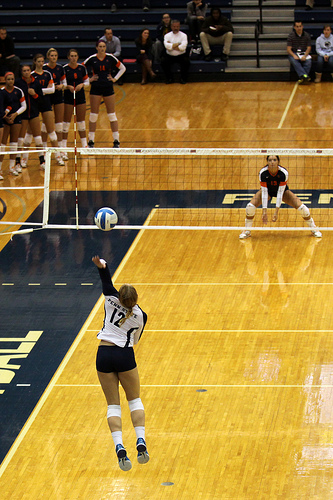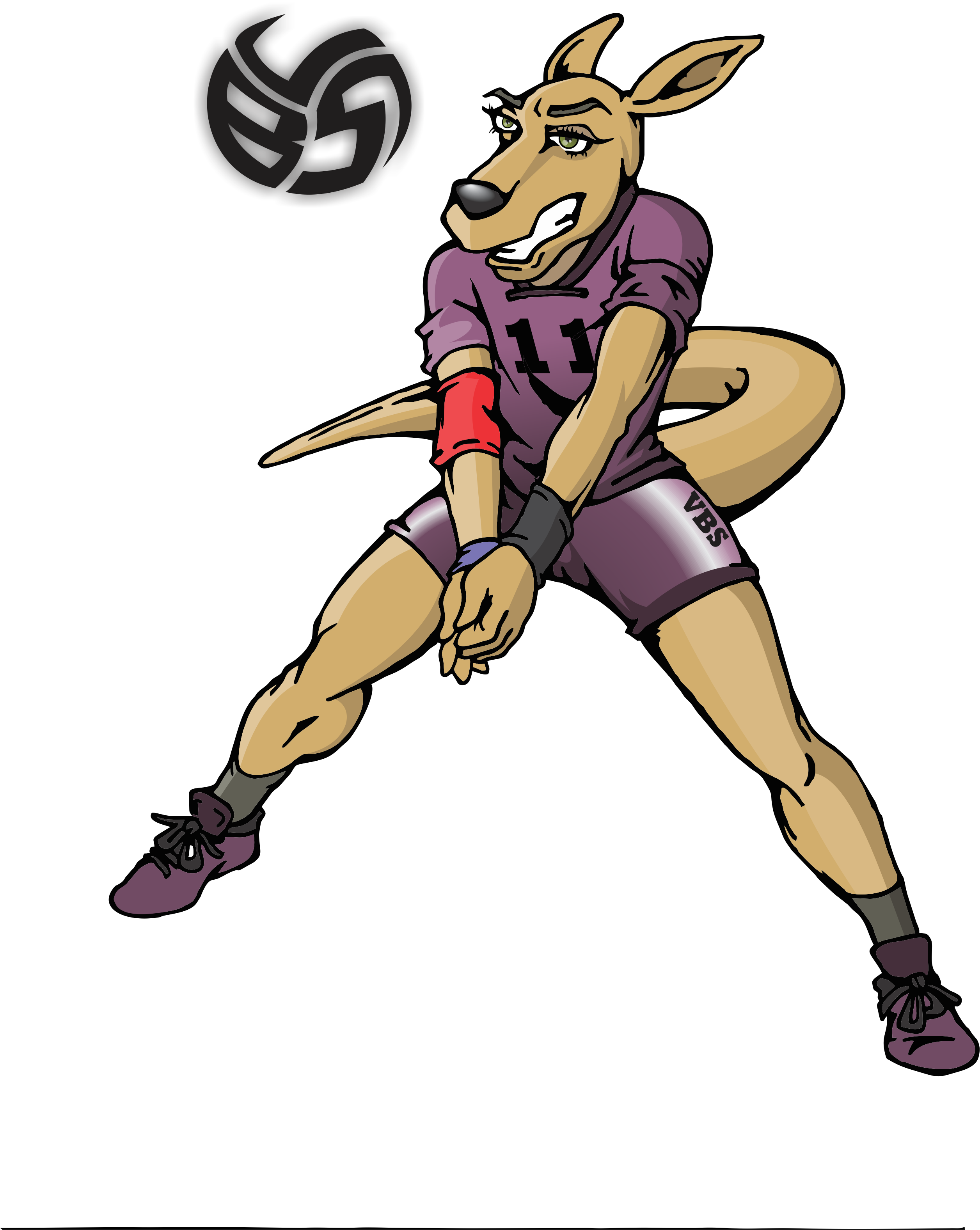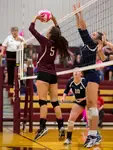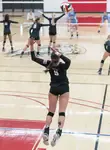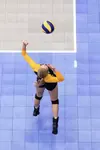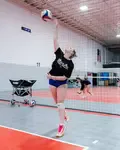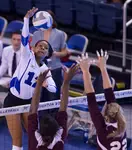 NOVEMBER Group Training with Coach April
Registration is NOW open for Group Training Sessions with me Coach April For BOYS on SATURDAYS 11/8, 11/22, 11/29
For GIRLS on SUNDAYS 11/9, 11/23, 11/30
From 10-11am at the Its All Volleyball gym.
Email: info@improveyourvolley.com to register or for more information
NOVEMBER Group Training with Coach April
Registration is NOW open for Group Training Sessions with me Coach April For BOYS on SATURDAYS 11/8, 11/22, 11/29
For GIRLS on SUNDAYS 11/9, 11/23, 11/30
From 10-11am at the Its All Volleyball gym.
Email: info@improveyourvolley.com to register or for more information- Improve Your Volleyball with Coach April
- High School Varsity Volleyball
- Varsity Volleyball Passing
A Volleyball Passing Guide On How To Improve Volleyball Bumping Skills
Volleyball passing is the way to contact the ball with your forearms to guide it to your setter or over the net so developing a good forearm pass is crucial.
Volleyball passing is the way to contact the ball with your forearms to guide it to your setter or over the net, so developing a good forearm pass is crucial.
In addition to the fundamentals discussed earlier, there are specific aspects I want you to consider in order to improve your passing skills.
Volleyball Passing: Pass Placement
The accuracy of your pass is important in ensuring a successful offensive play.
When passing the ball, aim to guide it to the target area or directly to your setter.
Here are some tips to control the angle and direction of your pass:
1. Visualize Target Areas:
Before the ball reaches you, mentally visualize the ideal landing spot for your pass. This can be an area on the court (e.g., close to the net for the setter or to a specific teammate for an attack) or directly to the setter's hands.
By having a clear target in mind, you can better control the direction of your pass.
2. Controlled Arm Swing:
As you make contact with the ball using your forearms, focus on the direction of your arm swing. Think about guiding the ball towards your intended target.
For example, if the setter is positioned on your right, slightly aim your pass in that direction.
3. Adjusting Body Position:
Use your footwork and body positioning to influence the angle of your pass.
If you need to pass more towards one side of the court, adjust your body orientation by angling your hips and shoulders slightly in that direction.
This subtle adjustment can help redirect the pass towards your intended target.
4. Practice Different Scenarios:
During training sessions or scrimmages, deliberately practice passing to different areas of the court.
The more you familiarize yourself with different pass placements, the better prepared you'll be in actual games.
I like to work on this 3 person "Dodgeball" drill where the person in the middle has to choose which side to get their midsection out of the way of the oncoming ball that's being tossed at their chest before they present their passing platform with an angled shoulder positioned towards the target.
How can you get better at volleyball passing?
You can start building better passing skills by paying attention to the body positioning of the server on the opposing varsity or JV volleyball team.
Here's the deal.
For Better Volleyball Passing
Watch The Opposing Server For Clues
When a player is ready to serve the ball, she will give you some indication of where she plans to serve.
If you are on the high school volleyball team that is receiving the serve, you should be checking the position of the opposing team's server's lower body, her feet and especially her hip position which will provide you some clues as to where the server will serve.
For a few more clues as to where the server may serve the ball, you should check out where the server's shoulders are facing and where her tossing arm is pointing.
That's a clue, Sherlock!
This is a pretty good indication that a short serve is coming.
When you notice the server doing this, then you want to adjust accordingly, by taking a step closer to the net so that you won't be taken by surprise by a ball landing just inches from the net on your side.
You position yourself to be ready to cover any short serves that come in your area.
For Better High School Volleyball Passing
Talk About Who's Going To Pass The Ball
Another way to build better volleyball passing skills is to communicate and talk to your teammates about who is going to pass the next ball that comes in or around your area.
There's no getting around it, if you play volleyball, then you are going to have to learn to be vocal and communicate on the court with your teammates.
You need to be ready to take personal responsibility for balls that are served or passed into your area.
That means balls within one or two feet of you and balls that are served between you and the teammate next to you.
First, you should be ready to call the ball, by calling "me", "mine' or 'I got" or "out" in a loud clear voice so your teammates know that you are taking responsibility for passing that ball.
Taking vocal responsibility allows your teammates to set up early for whatever they need to do next.
You're helping them without saying you are helping them.
Coach April Chapple's 100 Volleyball Passing Tips For Youth Volleyball Players
You can also tell your teammates something else.
You can communicate to them what type of serve you think the opposing team's server is about to serve.
If you see someone stepping up really close to the service line then you should tell your teammates in a loud voice "Watch out for the short serve!"
This mentally helps your teammates to prepare to move quickly if the short serve comes. This way you are doing your part to let your team know that the short serve is possibly coming.
I really hope these passing tips help you to improve your high school varsity or JV volleyball passing skills.
Scroll down to check out more high school varsity volleyball tips and information below.
Do You Follow Me on Pinterest?
 Private or semiprivate volleyball indoor/sand lessons are an excellent way for young Las Vegas high school volleyball players to quickly improve their individual skills through a private or semi-private coaching experience.
These lessons are conducted by former pro volleyball player, former USA Volleyball High Performance instructor and Evaluator and Tstreet Vegas 18s head Coach April Chapple on a weekly basis.
Sign up now!
Private or semiprivate volleyball indoor/sand lessons are an excellent way for young Las Vegas high school volleyball players to quickly improve their individual skills through a private or semi-private coaching experience.
These lessons are conducted by former pro volleyball player, former USA Volleyball High Performance instructor and Evaluator and Tstreet Vegas 18s head Coach April Chapple on a weekly basis.
Sign up now!Follow me on Pinterest Volleybragswag to improve your game even faster!
I share alot of individual, partner and easy-to-do volleyball serving drills we do in class with my followers.
Many of these volleyball practice drills you can do at home by yourself or try at your next practice with your teammates.
If you're a B team or JV player trying to make varsity next year...your goal should be to complete 1000 reps a day of at least three of the basic skills on your own...volleyball passing, serving and setting should be at the top of the list.
Improve Your High School Varsity Volleyball Skills
Where Do You Go From Here?
Your three options are:
- You can learn more about Volleyball Passing by visiting the Related Links below.
- Follow the suggested reading on our Sitemap page Learning How To Play (Sitemap)
- Or visit the pages in the How to Play Volleyball section in the drop down menu at the top of the page to get started.
- Before leaving this page Say "Hi" to Ms. Resee the Kangaroo, wearing the #11 jersey below. She's a left side hitter with precision passing and a member of the VolleyBragSwag All Beast Third team.
Meet Resee the Kangaroo and Passing Specialist on
VolleyBragSwag's All Beast Team
If your athlete struggles with consistent serve receive, gets subbed out, or is overlooked for playing time—this is the fix you’ve been looking for.

Struggling with passing consistency?
I help talented passers tired of getting pulled from games because of inconsistent serve receive skills BUILD passing confidence without expensive private lessons using the same 3-step system that's helped dozens of my athletes get recruited.
Download my eBook for $17.99 and start building the passing confidence that keeps you on the court—and gets you seen by college coaches.
From Lady Vol to Legend: Coach April Produces Powerful Passionate Players...is that you?

What Are You Looking For?
Click to Download Your Pre Serving Ritual Mastery Checklist pdf:
🎯Volleyball Pre Serving Ritual Guide -
Players! Learn How To Transform Your Serve from Weak to Weapon
Click to Download Your Parent's Volleyball Serving Checklist pdf
🎯Parent's Volleyball Serving Checklist Guide
Parents! Help Your Player Develop Championship Serves (Even If You've Never Played)

Hi there!
Thanks for stopping by. Hope you learned something today that will help you reach your volleyball goals.
Be sure to subscribe to my email newsletter so you can learn more each week!
Stay strong! Stay motivated!
-Coach April

SUSCRIBE to my email newsletter below!

 Click to learn more about the weekly volleyball classes and clinics or email info@imrpoveyourvolley.com for information
Click to learn more about the weekly volleyball classes and clinics or email info@imrpoveyourvolley.com for informationCongratulations to my seven Boys-18s Vegas Volley club players who played in two state championship finals yesterday, the 3A and 5A State champinship finals at Sunrise Mountain High School.
TOURNAMENT CHAMPIONS!
A-1 Vegas Volley VBC
In It To Win It Tournament
May 2 - 4, 2025 Tournament
Gold Medalists
18s Premier Division
Vegas Volleyball's Unsung Heroes: Celebrating Moms with Peace Love Volleyball Shirts
Ready to energize your volleyball mom journey?
Subscribe to my 'Producing Powerful Passionate Peaceful Players' email list above on ImproveYourVolley.com.
You'll receive energy-boosting tips, exclusive insights from me, Coach April Chapple on maintaining momentum in volleyball.
Let's power up the Vegas volleyball scene together!
Recent Articles
-
Volleyball Topspin Serve: How To Score Aces With Power and Spin
Nov 10, 25 03:10 PM
Want to add 3-5 aces per game? The volleyball topspin serve combines power and spin to score points. Learn the technique that makes passers fear your serve. -
5 Hitting Volleyball Drills Helping You Learn To Hit The Ball Harder
Nov 05, 25 12:33 PM
With these hitting volleyball drills, you have to adopt a fearless and aggressive attitude when it comes to spiking the ball against a two person block. -
Two Hitting Drills Volleyball Players Do To Learn To Beat The Block
Nov 05, 25 12:32 PM
Here are two hitting drills volleyball players use in our practices to teach our hitters how to beat the block while hitting or attacking at the net.
 Resee the Kangaroo Shirts
Resee the Kangaroo Shirts Resee the Volleybragswag Kangaroo Shirts available now.
Resee the Volleybragswag Kangaroo Shirts available now.








